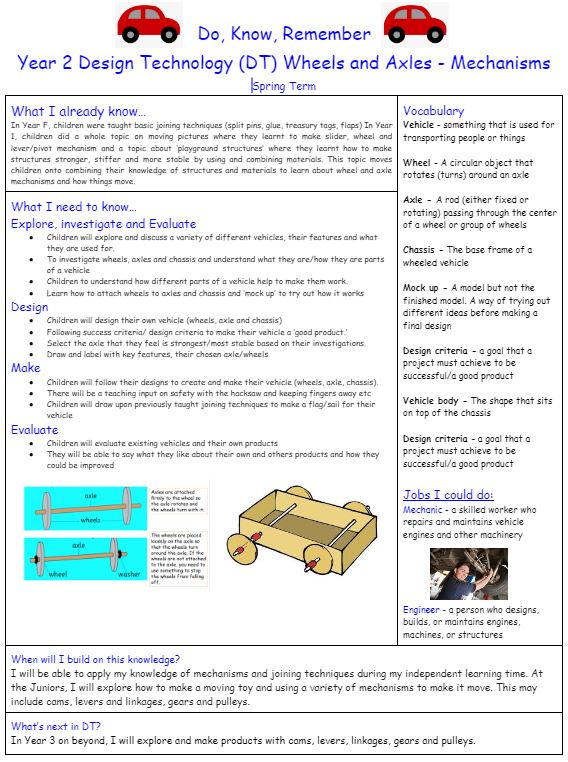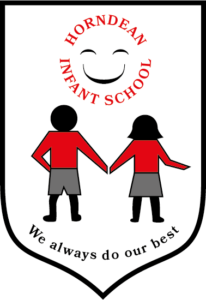Design and Technology (D.T.)
Our Intent, Implementation and Impact statement for D.T.
Intent
At Horndean Infant School we aim to provide children with a DT curriculum which enables them to use their creativity and imagination. We want them to become confident in evaluating products, and designing and making in a range of contexts with strong purpose. At Horndean Infant School, we want to make sure that children have appropriate subject knowledge, skills and understanding set out in the National Curriculum Programme of study. To fully embed new skills and knowledge, the long term planning has been designed to ensure that skills are revisited and built on throughout KS1 so children can remember prior learning and use this to carry out more complex tasks year after year. We want our children to confidently talk about their learning in DT and give equal weighting to the two strands of the National Curriculum : Designing and Making and Food and Nutrition. Most importantly, DT at our school is practical, hands on, allows pupils to think creatively about their designs and products and enable them to design and make something for somebody and for some purpose. As DT lead, we continue to consider how we can give deeper purpose to the learning and how we can make links within the community to support this.
Implementation
Our curriculum offers a range of exciting units that solve real and relevant problems. Through these units, we learn and apply a range of technical skills including structures, mechanisms, textiles, materials and food. There are clear links to DT knowledge and skills in maths, science, computing and art. Design Technology is planned using the children’s prior knowledge and experiences. On long term planning, units are shown that are taught throughout the academic year. Medium term planning outlines progression, sequences of lessons and considers differentiation. All teaching of DT, regardless of the unit, follows the evaluate, design, make cycle. Children are given choice about their designs and products and are given a range of tools to choose freely from. They are given the opportunity to make mistakes and improve their products as they go along the making process. Children also evaluate their own products against design criteria, rooted in technical knowledge and vocabulary. This means they can measure how successful their end product is against what they set out to do.
The key skills we teach are:
- Cooking and nutrition
- Mechanisms
- Structures
- Textiles
Key to NC link Evaluate Technical Knowledge Design Make Cooking and Nutrition
| Unit of Work in DT | Intent (Why?) | Implementation (What?) | Impact (How?) |
|
Year 1 – Autumn Moving Pictures (Mechanisms) |
Explore and evaluate a range of existing products and evaluate their own ideas and products against design criteria Explore and use mechanisms (such as sliders and wheels) in their products Design purposeful, functional and appealing products for themselves and others based on design criteria Generate, develop, model and communicate their ideas by talking, drawing, templates and mock-ups Select from and use a range of tools and equipment to perform practical tasks (eg. cutting, shaping, joining, finishing) |
Children will follow the cycle of evaluating, design, make, evaluate throughout this unit. They will explore and evaluate existing mechanisms to make pictures move using example books, designing, mocking up and eventually creating their own moving picture based on their animal topic. |
Children will be able to explore and evaluate existing products, practise making 3 different mechanisms in taught sessions (slider, wheels and lever/pivot) discussing how these mechanisms work. They will then make decisions about which mechanism(S) they like best and why and design their own moving picture. They will evaluate their product against design criteria and be able to talk about how their chosen mechanism works Children will be able to apply the skills and technicalities around this unit in their own learning time. ie. Choose to make a picture move using a taught mechanism Purpose – consider this (could these products be displayed somewhere? For who? |
|
Year 1 – Autumn Christmas Puddings (cooking and nutrition) |
Use the basic principles of a healthy and varied diet to prepare dishes Understand where food comes from Select from an use a wide range of (ingredients) |
Children will discuss, simply,the traditions of Christmas puddings (English and traditional to make a wish etc) and follow a given recipe to make their own mini xmas pudding. Children will also discuss the ingredients used and reasons why (breadcrumbs to soak up moisture etc) and will apply some simple preparation techniques from cleaning down tables hygienically to halving cherries with a safety knife etc. |
Children will understand the importance of hygiene and safety when cooking and preparing ingredients They will be able to give some facts about where Christmas puddings come from and therefore understand that other dishes originate from other countries, further than their own. They will be able to use words related to cooking such as stir, beat, fold etc to explain the process of combining ingredients. They will understand the importance of following a recipe |
|
Year 1 – Spring Fabric Faces (Textiles) |
Explore and evaluate a range of existing products and evaluate their own ideas and products against design criteria Select from and use a range of tools and equipment to perform practical tasks (eg. cutting, shaping, joining, finishing) using textiles according to their characteristics Design purposeful, functional and appealing products for themselves and others based on design criteria Generate, develop, model and communicate their ideas by talking, drawing, templates and mock-ups |
Children will explore a range of fabrics and look at their properties/characteristics. They will learn to name some basic textiles/fabrics – felt, lace, ribbon etc… They will ‘mock up’ by using a range of joining techniques (staple, sew, glue) to join materials onto binca through exploring a range of textiles They will become familiar with using templates and pinning them onto a fabric as an outline for a finished product. They will design a fabric face using their knowledge of joining techniques and create a face onto hessian, using appropriate materials for the job. |
Children will understand that there are many different materials/textiles that can be used for different purposes and effects. They will be able to use running stitch, along with other previously taught joining techniques (YF) to join materials together |
|
Year 1 – Summer Dips and Dippers (cooking and nutrition) |
Use the basic principles of a healthy and varied diet to prepare dishes Understand where food comes from Select from an use a wide range of (ingredients) Design purposeful, functional and appealing products for themselves and others based on design criteria Generate, develop, model and communicate their ideas by talking and drawing Select from and use a range of tools and equipment to perform practical tasks (eg. cutting) Explore and evaluate a range of existing products and evaluate their own ideas and products against design criteria |
Children will sample (taste) and evaluate supermarket ‘dips’. They will explore the parts of the world where some dips come from (ie. raita – India) They will then sample and evaluate supermarket ‘dippers’ (carrot sticks, breadsticks etc) Children will then make some dips (using a recipe) before planning/designing their own dip/dipper and then evaluating it against the design criteria |
Children will understand what dips and dippers are and how they are made. They will begin to understand some cooking terms (cut, grate, marble, layer) They will be able to evaluate existing products, describing what they like/dislike |
|
Year 1 – Summer Technical Knowledge – Structures |
Explore and evaluate a range of existing products and evaluate their own ideas and products against design criteria Select from and use a range of tools and equipment to perform practical tasks (eg. cutting, shaping, joining, finishing) Build structures, exploring how they can be made stronger, stiffer and more stable Design purposeful, functional and appealing products for themselves and others based on design criteria Generate, develop, model and communicate their ideas by talking, drawing, templates and mock-ups Select from and use a range of materials and components, including construction materials. |
Children will explore how playground equipment is made. They will experiment with joining techniques to design, make and evaluate their own piece of playground equipment They will practise how to make their structures stronger and more stable |
Children will be able to name and apply joining techniques to make their own structures. They will be able to evaluate how to improve their structures |

